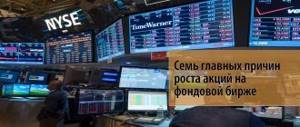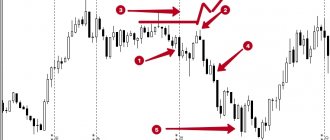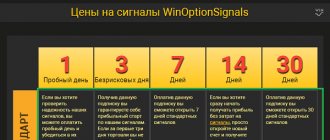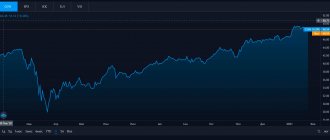Greetings, dear subscribers and guests of the Tevola.ru website!!!
Major players certainly know about our weaknesses, and they make money from this. Do you think they don’t have mistakes?, of course they do, but only they work in teams and control each other, and we have to deal with our weaknesses alone.
But we can absolutely say that we will be able to remake ourselves, not make typical mistakes and move to a new trading level, the main thing is to know what to fight, and this is what will be written here.
There are a lot of articles on the Internet on this topic, and they are written like a carbon copy about the same thing. After reading articles from other sites, comparing the mistakes described in my journal, the thought came to my mind: “Why the hell at the very beginning of my journey, I was not looking for traders’ mistakes, but trying to find a strategy and make money?”
This is greed and stupidity, guys. So, I pass on my experience to you: “Start mastering the path of a trader not with your big shots, you already have enough of them, but learn from the mistakes of beginners and experienced traders.”
Lack of preparation
One of the most common mistakes a trader makes is lack of preparation. Trading is one of the most difficult professions. This is where you constantly need to remain extremely competitive and constantly maintain your edge in the market, even when you are well prepared. However, many newcomers are ill-prepared to enter the market. They feel as if they will succeed and as a result they lack any preparation before the trading session.
You must understand that you are competing with large financial institutions, hedge funds and other market professionals who are very well prepared. And in order for you to be able to compete with them on the same playing field, you must at least do your homework every day, as well as constantly study the markets in which you trade.
Whether you are a fundamental trader or a technical trader, you must have a daily routine that you follow so that when executing your trading plan, you do everything flawlessly and without emotional fluctuations.
1. Treat stock trading as a game, not as a job
Often the expression “playing Forex” is taken literally by many new traders. Trading in the foreign exchange market is like a casino for them, where luck is the main force. Accordingly, knowledge does not play the main role for them, and passion is a natural component of the process.
If you want to succeed in Forex trading, approach this business in the opposite way: trading on the currency exchange is painstaking, complex work, and gambling is absolutely unacceptable here. As soon as a trader begins to be guided by emotions in the trading process, we can assume that he has already lost his capital. Dispassion, cold calculation and knowledge of the matter are the three pillars of successful trading.
You don't limit your losses
I'm sure you've heard stories of traders making money consistently and then losing it all. Why is this happening?
From a psychological point of view, everyone always wants to be right. Therefore, it is not surprising that many traders have this setup. By always wanting to be right, you won't limit your losses when the price goes against you. Because when you accept losses, you admit that you were wrong.
So instead of limiting your losses, you hope and wait for the market to eventually turn in your favor so you can be right in your prediction. Sometimes this can happen, but in the end you will lose a lot more.
Trading is not about being right all the time. It’s about admitting you’re wrong as quickly as possible and cutting your losses.
Risk management is the most important thing in trading. And one of the best ways to manage your risk is to always use a stop loss. I would say that you should only use a stop loss for each trade.
Many new traders either prefer to use a “mental stop” with a predetermined level at which they plan to exit with a loss. Or, worse, they refuse to use a stop loss at all because they are so confident in their position that they don't think about anything else. Both of these approaches are fundamentally flawed.
Regarding the first approach in favor of using a mental stop loss, I believe that it is simply an excuse for the trader to stay longer in the market. If they have already determined the trade's invalidation point, then the trade should not be given additional time and therefore a hard stop loss would be best.
Regarding the second approach, I can say the following:
“The only certainty in the market is uncertainty.”
Large and unexpected losses caused by trading without stops are a mistake many new traders make.
Overconfidence
Overconfidence can occur after a series of profitable trades. The trader may have the impression that he has understood all the secrets of the market and will now make a profit on every trade. This leads to mindless trades that violate the rules of the trading system and cause excessive risks. The trader begins to rely too much on their forecasts, believing that the market “should” go in their direction. But the market does not care about your forecasts - and an overly confident trader gets rid of his illusions along with the profit received or the entire deposit as a whole. Therefore, do not let a series of profitable trades cloud your judgment, always trade carefully and thoughtfully.
Poor risk/reward ratio
Many novice traders mistakenly believe that the best trading strategies are those that show the highest percentage of profits. As a result, they usually choose strategies that have a winning rate of 70%, 80% or even 90%. But these strategies often have a high risk of losing your entire deposit because they typically have a very low risk-to-reward ratio.
Let's look at two examples. One of them is a strategy with a high level of profit, and the other is a strategy with a moderate level of profit:
Strategy A wins 70% of the time, with the amount for a winning trade equal to half the amount for a losing trade. Strategy B wins 40% of the time, and the amount for a profitable trade is 2 times higher than the amount for a losing trade.
Which of these two strategies do you think is more profitable? If you answered Strategy B, you would be correct. Although this strategy has a much lower profit percentage. Let's see why this is so:
The expected return is calculated as follows (let’s assume that our deposit is $500):
(Percentage of Profit x Average Size of Win) – (Percentage of Loss x Average Size of Loss)
(70% x 250) – (30% x 500) = $25
Strategy B:
(40 x 500) – (60 x 250) = $50
Traders should not believe the myth that strategies with higher profit margins are better than strategies with lower profit margins. Traders should not only focus on the profit percentage, but also take into account the risk-to-reward ratio for each trade.
Forex Mistakes - Trading Addiction
Currency trading is a very gambling activity. New traders are especially quick to get carried away with it. They most often choose scalping or intraday trading, that is, short-term trading.
It is characterized by a minimum of analysis and quick response. Well, there are still high risks. If you have recently discovered Forex, we advise you to learn from daily charts, while constantly updating your theoretical knowledge.
Long-term trading requires more competent and disciplined money management. Therefore, long-term traders make sure to stick to the 1% rule so that they can calmly face the daily swings of 100-150 pips that happen to some pairs throughout the week.
Long-term trading has one important advantage - you don’t have to sit in front of a monitor all day. Your participation will be needed only once a day - during the closing of a newly formed candle.
Constant learning, daily analysis of your trading, as well as patience and consistency will help you become a successful trader. Ignoring these aspects is the greatest mistake a Forex trader can make.
You take profits on emotions
When I first started trading forex, I was constantly losing money. The market always seemed to go against me. So I often took too little profit out of fear that the market would turn around again and I would make no money again.
In the end, I still lost money. For example, out of 10 trades I had 6 unprofitable and 4 profitable. I lost $600 on losing trades and earned $400 on profitable trades. As a result, the total loss was $200.
My profits were too small because I exited profitable trades too early. This trader's mistake gradually drained my deposit.
So don't close your trades out of fear that the price will reverse. Wait for an obvious reversal signal. This strategy ensures that you will make more profits to compensate for your losses.
7. Trading against the trend
Traders like to repeat the aphorism “trend is your friend,” which means “your friend is the trend.” Novice traders neglect this axiom, often opening trades against the direction of the price. The explanations are the most banal: “it’s time to turn around,” “the rise/fall has been too long,” etc. Such assumptions have nothing to do with reality: the price can fall (or rise) for as long as desired. This is exactly what happens from time to time updating the minimum and maximum prices of various currency pairs. Only based on clear trading signals indicating a reversal can a decision be made. Don't rely on your own assumptions if you don't want to lose money.
Retrading
What attracts many new traders often leads to their financial ruin. I mean the temptation of quick money and the opportunity to be in the market 24/5.
Novice traders believe that in order to make money in the markets, they need to trade around the clock. However, this is far from the truth. In fact, I would argue that the exact opposite is true. Instead of trading on the 5-minute time frame, it is much more financially and emotionally effective to trade on higher time frames, such as the 4-hour or daily chart.
In addition to offering better trading setups, these higher time frames also have the advantage of lower transaction costs due to less frequent trading.
It's not how often you trade, but how well you trade. We are not paid for the hours we spend at the market. So take a step back and start focusing on making rarer, higher-quality trades.
Bonuses from trusted Forex brokers
- Invest and receive up to an additional 5000 USD,
claim bonus - Register and get 30 USD for trading,
free 30 USD
The global Forex market requires serious training from specialists working on it. But even the highest level of knowledge and ability to make forecasts does not guarantee against unsuccessful transactions and financial losses. In such conditions, the personal experience of unsuccessful trading by novice traders is of greatest value.
Since the largest number of mistakes are made at the initial stage, when the trader does not have enough experience, talking about these mistakes will be especially useful for beginners. Let's talk about the main mistakes in Forex trading that are typical for novice traders.
The number of traders on the global Forex market is growing every year. This is not surprising, since Forex gives every person the opportunity to receive a decent additional or main income. But not everything is simple: not everyone can effectively take advantage of this opportunity, and many traders quickly lose investment capital due to trading errors. What mistakes are most common for an inexperienced trader?
Choosing the wrong position size
Experienced traders know that position sizing is critical to trading success. In fact, it is often the difference between success and failure. Therefore, it is important to adhere to strict parameters for determining position size and use some kind of fixed calculation model. However, no guesswork or intuition should be involved in this process.
For example, a professional trader, based on his trading plan, can allocate 2% of his capital to any trade. This will be considered a 2% fixed fractional model. Thus, if a trader has an account of $50,000, the maximum risk allowed will be $1,000. And if a trader, based on analysis of his charts, decides that the most logical stop level is $450 of the entry price, then he will be allowed to allocate a maximum of 2 lots to this trade.
Beginning traders often calculate risk based on the last trade rather than relying on a pre-planned position sizing model. They often take oversized positions after winning trades and often end up on the wrong side of the market, which in turn results in large losses.
Going on tilt
Tilt is a condition in which a trader makes rash trading decisions after a string of losses. His actions are largely based on emotions.
The advice here is the simplest: if trading is not going on, then it is better to take a break. This is difficult, because it seems that after 5 losses in a row, the next trade will definitely be profitable. But as practice shows, it is best to close the trading terminal and not trade at least on this day.
A series of losses in trading will happen periodically and regularly. It is impossible to always just make money and fully predict movements on the stock exchange.
Belief that the market is overbought or oversold
I grew up in a middle-income family, so we were constantly saving money. Often we bought items that were on sale for the lowest price. But how does this relate to trading? In my early days in the market, I used the same principle in my trading: I wanted to buy at the lowest prices and sell at the highest.
Therefore, when the price was at its minimum levels, I expected a reversal and waited for a signal for a pullback. But often the trend continued to move, but the reversal never occurred.
Because I thought the market was oversold, I missed long-term trends. This behavior pattern cost me a lot of missed opportunities.
So now I always know that the market is never too oversold or overbought.
Reanalysis
After opening a trade, news comes out that can change the direction of the market. Because of this, the speculator leaves the market, and after 15 minutes he sees that the situation has not changed and the price continued to move in the initially predicted direction.
Behavior indicates lack of confidence.
To make sure the forecast is correct, the trader begins to look for additional analytics and absorbs all the information received - there are too many analytics and not all of them are correct.
To get out of overanalysis, you need to learn how to work with a schedule. Then you will have confidence in your strength and an understanding that most contradictory news on the Internet is useless.
Overanalysis
Trading can be a lot of fun. You have access to a variety of indicators, trading tools and strategies.
Like most new traders, I tried to learn every new trading strategy I learned about. Price action, indicators, harmonic patterns - I tried it all.
Since I used several trading strategies at the same time, there were often situations when I received two opposite signals. For example, the price action setup indicated that you need to buy, while the indicators indicated overbought. Due to the many signals, it was difficult for me to enter the trade.
Therefore, I abandoned all trading strategies that did not work for me or did not suit my trading style. When I did this, I was able to analyze the market more clearly and objectively.
Fast profit taking
Beginner traders like to take profits. They think it's easy money. How can they not be recorded? What if the quote reverses?
As history shows, it is better to hold profitable positions for a long time while there is an upward trend. Traders sometimes, having entered into a trade well, quickly get rid of it. After which the quotes only accelerate their growth, since this was only the first impulse of the beginning of the trend.
We tend to take early profits purely psychologically. We want to receive a guaranteed income, even a small one. The situation with losses is different. We categorically do not tolerate them and are ready to hold unprofitable positions for a long time, just not to lose.
- Psychology of trading in trading;
- How to understand that it is worth selling assets;
Emotionality
Often, new traders experience emotional ups and downs in their trading. When the price goes their way, they feel happy. When the price goes against them, they feel sad and disappointed. When they receive a losing trade, they become overwhelmed with despair and depression.
When a new trading opportunity arises, traders continue to experience emotions from past trades. If the previous trade was unsuccessful, traders will be hesitant to open a new one. If the trade was successful, traders may mindlessly enter trades without relying on the quality of the trading signal and often violate their trading plan.
Emotions should not dictate your trading decisions. The good news is that if you stay in trading long enough, emotions will no longer be a problem for you. You will realize that the market is too unpredictable to worry about.
There is no need to give in to emotions because they interfere with your trading.
2. Neglect of knowledge of the basics of trading and reluctance to gain trading experience on demo versions
A very common mistake. Many novice traders believe that opening trades should be done purely intuitively. Forecasts of exchange rates, they believe, should be based not on knowledge of certain patterns and information, but on the trader’s instincts. Since the market is a force of nature for such traders, scientific assessments and forecasts are impossible. Understanding the nuances of the market, painstakingly studying charts of currency price movements, trying to understand the patterns, is boring for such players. Intuition and luck are their methods. Transactions “for luck” rarely end well, and the likelihood of such a trader losing his deposit is much higher.
Micro-management of transactions
A common mistake traders make is switching to lower timeframes for a more accurate analysis of an open trade.
For example, on a 4-hour chart, you open a sell trade on EUR/USD when the price tests the 20 EMA. Your stops are placed at the 50 EMA.
The price moves in your favor and the next candle engulfs the previous one. You are glad that everything is going as you planned.
Next you see a pin bar that is directed against you. Are you starting to worry that the price will reverse and think that it might be better to take the profit that is still there?
You open the 15 minute time frame to see the price action in detail and notice that price is making higher highs and higher lows against your position. It seems to you that this indicates a change in the current trend and that it would be better to take the profit that is still there.
However, after a few days, the higher timeframe chart already looks like this.
If you had followed your original plan and ignored the lower time frames, you could have made another 600 pips.
Therefore, never go down to a lower time frame to manage an open position. Focus only on the current timeframe to find an entry point, set stop losses and take profits.
Managing your position is perhaps one of the most difficult aspects of trading. And the reason for this is that the moment you enter a trade, your objective analysis disappears somewhere. You become biased and start seeing what you want to see. At the same time, your subconscious mind will filter out things that do not correspond to your profit plan.
A great way to trade is to use a “set it and forget it” strategy. In this style of trade management, you do all your analysis before entering the market, when you are most objective. You define and set your stop loss and profit target the very moment you open a new position. And then you just let the market do its thing.
Averaging
Averaging down losing trades is the most serious mistake a trader can make.
Many traders are tempted to average out losing trades because it seems like a safe bet at first glance. Let's look at this from a roulette point of view for a moment. You have almost a 50% chance of winning or losing by betting on red or black.
You decide that you will double your bet every time you lose and you should come out ahead as a result. You start with $100 and double your bet every time you lose. This is what this scenario will look like after 8 consecutive losses, which is typical for both roulette and trading:
- 100$
- 200$
- 400$
- 800$
- 1600$
- 3200
- 6400
- 12 800
Although this is a fairly simplified example, it should show you that averaging trades is a terrible strategy for roulette and even worse for the financial markets. Sooner or later you will lose your entire deposit.
Following other people's advice
Another mistake newbies make may be blindly following other people's advice. There are many advisors on the Internet who will always tell you how to invest “correctly”. However, not all of them are necessarily successful deals, and in any case you won't last long on someone else's wits, you need to know your own mind. This doesn't mean you shouldn't learn from others. However, you must understand the trading idea and check whether it suits your trading system. Be critical of other people's advice and only use what suits your trading system. A strategy that works well in the hands of one trader may be completely useless in the hands of another.
Too much focus on losing trades
One of the most common mistakes new traders make is equating losses with failure. And this is especially true for those who have reached great heights in their profession. These people are used to doing everything right and achieving their goals. And when they use this approach in the financial markets, it destroys their psyche.
First of all, anyone entering the world of trading must understand that losses are an integral part of trading. They must accept and overcome the negative emotions associated with losing trades.
Professional traders, on the other hand, recognize that trading is a game of probabilities and that no single trade, or even a series of trades, matters much. Thus, winning a trade or losing a trade does not affect their emotional state.
Recreational traders are much more exposed to recent trades, meaning that their mood and actions in the market are highly influenced by their recent trading results. These traders must take the necessary steps to view losses as a necessary component.
Psycho-emotional errors
trader mistakes
The word “ psycho-emotionality ” does not imply the stereotype “crazy”. The prefix psycho is a natural term for our emotional state. I think this is clear. Therefore, next we will look at the main mistakes of a trader, which are caused by our emotional state.
So, regarding trading, our emotions are divided into main components that directly affect the trading result. Also, it is worth recalling that emotions in trading exist both positive and negative. Let's consider the main emotions, briefly. And let’s start, perhaps, with the trader’s negative state when trading.
Not following a trading plan
If you want to be consistently profitable, you need to stick to a consistent set of actions. This is why you need a trading plan.
A trading plan is critical to your success because it gives you clear rules on how to behave in the market. Entry and exit points, position size, risk level - your trading plan should take all this into account.
However, there may be situations when you deviate from your trading plan and enter trades due to the current market situation or your mood.
For example, I am a supporter of trend trading and I like to enter the market only during trend movements.
However, if the market is in consolidation and I see that the price is near a resistance level and the stochastic is indicating oversold, I may be tempted to enter a trade.
Why is this approach dangerous?
- Your trading becomes erratic and you become distracted from finding only profitable setups for your strategy.
- This can lead to overtrading, causing you to become emotional and stop analyzing the market objectively.
Therefore, you should never find any excuse for entering the market contrary to your trading plan. This will do you more harm than good. Focus on just one approach and don't get distracted by anything else.
Search for the Grail
One of the things we all value is the ability to make choices. Having choice is a wonderful thing in most parts of our lives, but in trading it can sometimes hold us back from realizing our full potential.
What I mean? Simply put, freedom of choice in terms of trading strategies and systems can often lead us on a never-ending path to excellence.
If you've been in this game for a while, you know there is no Holy Grail trading system. Goldman Sachs doesn't have it, JP Morgan doesn't have it, and we as retail traders will certainly never have it. The sooner new traders understand this, the sooner they will be able to trade more productively.
Successful traders have a certain edge and they use this advantage in the market whenever the opportunity arises. They know that they can make trading mistakes and that there will be losing trades, even a string of losing trades, but this will not stop them from sticking to their strategy.
Beginner traders should also focus on choosing a trading style that suits their personality. They must then apply the chosen strategy to the market and give it enough time. Only then can they consider moving on to some other strategy.
Expectation from trading.
Now regarding the mathematical expectation from trading in general. Many, almost all, novice traders and people interested in financial markets think as follows: “While I’m saving money, I’ll slowly practice trading. In a month or two I will open an account and start trading. And then, you see, I’ll become quite rich.” Only adventurers and amateurs think this way!
Only after some time, say after 1-2 years (although this period of time directly depends on the degree of adequacy of the individual), understanding comes to the practicing trader. The realization that here, in the vastness of the financial markets, there is and never has been magic. Expectations of profit of 25, 50, 75 and 100% per month are not here. It's more like a world of illusions and dreams!
Pay attention to the interest rates offered by savings and lending institutions. It is unlikely that you will find conditions where you can deposit your hard-earned cash savings at more than 14% per annum! Although such percentage figures in the world of economics are considered fabulous conditions. Believe me, all of the above are very, very dubious organizations with a pseudo awesome reputation! You can clearly understand this by reading the material Key rate of the Central Bank of the Russian Federation
No trading diary
Any successful business owner will tell you that maintaining consistent records is very important. This is not only necessary for tax purposes, but it also allows the business owner to know where the income and expenses are coming from. They can use this information to cut unnecessary costs and achieve better results.
For a trader, our income is the profit from winning trades, and our expenses are our losses from losing trades. If we don't have a detailed log of our thought processes and trading events, how can we expect to improve our results?
Therefore, it is important that traders keep a trading journal and review it regularly. This is probably one of the best tips for beginners. Try to figure out what works and what doesn't work.
If you are serious about trading as a real business and not just a side hobby, you should start with a trading journal.
Reversing a Position
Let's imagine a situation: a beginner sees a signal and buys cryptocurrency. Then the asset price drops. The trader decides that he made a mistake in his analysis. He closes the purchase and opens the sale.
If the price reverses again, the trader reverses the position again. If the signal is correct, the trader pays the commission four times and receives a loss.
Trader turns over position due to small price fluctuations
Why does this happen : beginners are afraid of losing money and perceive paper losses too emotionally. They confuse microvolatility with the start of a new trend and constantly flip positions.
How to avoid the mistake : switch the schedule to a longer period. This way you won’t be distracted by minute fluctuations.
Bill Williams advises treating every transaction like buying a lottery ticket. The ticket price will be the maximum allowable loss. In other words: hold the trade until your stop loss is triggered.
Judging yourself
A good deal doesn't have to be profitable. A good trade is one in which you followed your trading plan to the end.
Let's imagine the following situation. You open a position and the price immediately begins to move in your direction. You use a trailing stop. Profits gradually increase and your mood improves. However, you soon notice that the price gradually turns around and begins to move against you, eventually reaching your trailing stop. You start beating yourself up, telling yourself that if you had been more patient and not tightened your trailing stop, you could have made more money.
However, it is impossible to say for sure where the market will move. It is also impossible to exit trades at the highs or lows of the price movement. So don't blame yourself if you weren't able to capitalize on the entire potential move on one trade. This is normal and these situations will happen all the time.
4. Trading without a strategy, acting despite the development of the situation
You should not even try to trade without a carefully prepared and tested strategy. You need to enter the real market only after the final adoption of the trading strategy previously tested on the demo version. For each day, a detailed trading plan must be drawn up with a clear indication of all the circumstances of opening a transaction (currency pair, direction of price movement, stop-loss and take-profit levels, etc.). Unless force majeure circumstances arise, you must strictly adhere to the plan. You can use pending orders by specifying their duration.
Trader mistakes: let's summarize
Trading is like a sport. Consistent actions and habits ultimately determine the winner. The trader mistakes we have analyzed will help you improve your trading and begin to systematically work on yourself. After all, Rome wasn't built in a day, and successful traders don't appear overnight.
The first step in correcting your mistakes is admitting them. Take some time to review each of these common trading mistakes and see which ones are most relevant to you
You must make a concerted effort to improve your weaknesses. Keep in mind that there is no end point when it comes to trading. We all need to constantly improve. Even a 10-year trading veteran will tell you that he is still learning new things and constantly looking for ways to improve his trading performance.
Trading one share and the desire to win back on it
If a trader has lost money on a particular stock, then you should not focus all your attention on it. Many people try to re-login only to it, but this is a gross mistake. Why trade only one stock if there are no significant signals? This is only possible if you are angry at one particular action.
In trading, emotions are destructive. While you only follow one stock, you may miss other good opportunities. Therefore, there should be no favorite shares and a thirst for revenge.
A successful trader makes money where he sees opportunities and never deliberately returns to a financial asset in order to win back losses, to increase his “ego”, which he was able to do. There is no point in proving something to the market.











